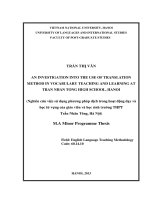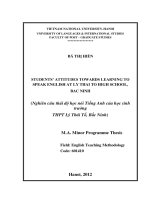Teacher talk at Ly Tu Tan High school, Hanoi and Its implications for effective classroom interactions
Bạn đang xem bản rút gọn của tài liệu. Xem và tải ngay bản đầy đủ của tài liệu tại đây (168.3 KB, 5 trang )
Teacher talk at Ly Tu Tan High school, Hanoi
and Its implications for effective classroom
interactions
Việc sử dụng ngôn ngữ của giáo viên tại
trường THPT Lý Tử Tấn, Hà Nội và những
gợi ý để đạt được sự tương tác hiệu quả
trong lớp học
Lê Thanh Hoa
University of Languages and International Studies
M.A. Thesis. English Teaching Methodology; Mã số: 60 14 10
Supervisor : M.A. Nguyễn Thị Bích Ngọc
Năm bảo vệ: 2012
Abstract. The success of teaching depends to a large extent on interactions that occur
between teachers and students and the happening of interaction is affected directly by
ways of teacher talk. The aims of the study were threefold: (1) to investigate the
current situation of teacher talk at Ly Tu Tan High School; (2) to find out ways of
teacher talk preferred respectively by teachers and students; (3) to provide teachers
with some techniques crucial to making the classroom interaction more
communicative and effective. The subjects involved in the study are 102 students from
10th-groups (10A6, 10A7, 10A8) with the survey questionnaires, 3 teachers who are
currently teaching English to 10th form students with another set of survey
questionnaires. The research reveals that teachers occupy most of the time in
classroom by introducing, explaining, telling and giving - a real kind of monologue. In
initiating an interaction, invitation is the first preferred choice by both teachers and
students, but the least employed one. In ways of follow-up, when students produce no
answer or an incorrect answer, teachers usually prefer ways of prompting, and this is
what teachers really did in class. However, students prefer to be informed by the
teacher. When students provide the expected answer, they also prefer to be
commented, rather than being just simply acknowledged. It is suggested that teachers
should pay more attention to their language in the process of interactions with
students, so as to provoke more effective interactions in class.
Keywords. Tiếng Anh; Phương pháp giảng dạy; Ngôn ngữ; Giáo viên
Content.
This study is composed of three parts:
Part One: The Introduction presents the rationale, purpose, scope, method,
significance and the organization of the study.
Part Two: The Development consists of four chapters.
- Chapter One: Literature Review establishes the basic theoretical background from
the literature on classroom research and teacher talk.
- Chapter Two: Methodology describes the overall picture of how the research was
carried out from the first step of determining the research design to the last step of
gathering the results. Specifically, this chapter contains details of the setting, the
collection of the data for the research and methods of data analysis.
- Chapter Three: Data Analysis and Findings interprets the results of the study. This
chapter attempts to provide answers to the posed research questions and present the
findings with some comments as well.
- Chapter Four: Implications suggests some ideas for educational administrators,
teachers and students so that teacher talk in class can be improved.
Part Three: The Conclusion summarizes the main findings in the study, emphasizes
implications for more communicative teacher talk and points out the limitations and
provides some suggestions for further study on the field.
References.
1. Alexander, R. (2004). Towards dialogic teaching. Rethinking classroom talk, 2nd
ed. UK
2. Allwright, D., & Bailey, K. (1991). Focus on the language classroom. Cambridge:
Cambridge University Press.
3. Brown, H.D. (2001). Teaching by Principles. London: Longman, Pearson
Education.
4. Chaudron, C. (1988). Second Language Classrooms: Research on Teaching and
Learning. Cambridge: Cambridge University Press.
5. Cook, G. (1989). Discourse and language teaching: a scheme for teacher
education. Oxford: Oxford University Press.
6. Cook, V. (2000). Second Language Learning and Language Teaching (2ndEdition).
Beijing: Foreign Language Teaching and Research Press.
7. Crandall, J. (1999). Cooperative language learning and affective factors.
Cambridge: Cambridge University Press.
8. Cullen, R. (2002) Teacher talk and the classroom context. ELT Journal, 52(3), 179-
187.
9. Ellis, R. (1985). Understanding Second Language Acquisition. London: Oxford
University Press
10. Farrell, T.S. C. (2002). Classroom discourse: an introduction. Singapore:
National Institute of Education, Nanyang Technological University.
11. Gillham, B. (2000). Developing a questionnaire. Continuum, London.
12. Harmer, J. (1998). How to teach English. Longman.
13. Hoàng Văn Vân, Hoàng Thị Xuân Hoa, Đỗ Tuấn Minh, Nguyễn Thu Phương,
Nguyễn Quốc Tuấn (2006). Tiếng Anh 10. Nhà xuất bản Giáo Dục
14. Katz, A (1996). Teaching style: A way to understand instruction in language
classrooms. Cambridge: Cambridge University Press.
15. Larsen-Freeman, D.(2000). Techniques and Principles in Language Teaching.
Oxford: Oxford University Press.
16. Lemke ,J.L. (1990). Talking science: language, learning and values. Ablex
Pub. Norwood, New Jersey.
17. Likert scale – Wikipedia, the free encyclopedia
(
18. Long, M.H. (1981a). Input, interaction and second-language acquisition. New
York.
19. Long, M. H., & Sato, C. J. (1983). Classroom foreigner talk discourse: Forms
and functions of teachers' questions. Newbury House.
20. Malamah-Thomas, A. (1987). Classroom interaction. Oxford: Oxford University
Press.
21. Maslow, A. H. (1954). Motivation and personality. New York: Harper and Row.
22. Mc Carthy, M. & S. Walsh (2002). Discourse. Cambridge: Cambridge University
Press.
23. McCarthy, M. (1991). Discourse Analysis For Language Teachers. Cambridge
University Press.
24. Mehan, H. (1979). Learning lessons: Social organization in the classroom.
Cambridge: Harvard University Press.
25. Moon, J. (2000). Children Learning English. Oxford: Macmillan.
26. Myhill, D., Jones S., & Hopper, R. (2006). Talking, listening, learning. Effective
talk in the primary classroom. Open University Press: Philadelphia.
27. Nguyễn Quốc Tuấn, Lê Văn Canh, Nguyễn Thị Mai Hoa, Hoàng Thị Xuân
Hoa, Đỗ Tuấn Minh, Nguyễn Huyền Minh, Lương Quỳnh Trang (2007). Cẩm
nang Dạy và Học tiếng Anh THPT. Nhà xuất bản Giáo Dục
28. Nunan, D. (1989). Understanding Language Classrooms. New York: Prentice
Hall.
29. Nunan, D. (1991). Classroom interaction. Sydney: National Centre for English
Language Teaching and Research.
30. Nunan D. (1991)Language teaching methodology: A textbook for teachers.
Cambridge University Press.
31. Richards, J.& Lockhart, C. (1994). Reflective Teaching in Second Language
Classrooms. Cambridge: Cambridge University Press.
32. Sinclair, J. M., & Coulthard, R. M. (1975). Towards an analysis of discourse:
the
English used by teachers and pupils. Oxford: Oxford University Press.
33. Sinclair, J. and Brazil, D. (1982). Teacher Talk. London: Oxford University
Press.
34. Thornbury, S. (1996). Teachers research teacher talk. ELT Journal 50/4:
279-89.
35. Tsui, A. (1995). Introducing classroom interaction. London: Penguin.
36. Ur, P. (1996). A Course in Language Teaching. Cambridge: Cambridge
University Press.
37. Van Lier, L. (1996). Interaction in the Language Curriculum: Awareness,
Autonomy, and Authenticity. London: Longman.
38. Vygotsky, L. S. (1962). Thought and language. Cambridge, MA: MIT Press.
39. Zhao, X. H. (1998). Study of teacher talk in the intensive reading course at a
university level. Foreign Language World, 2: 17-22.









